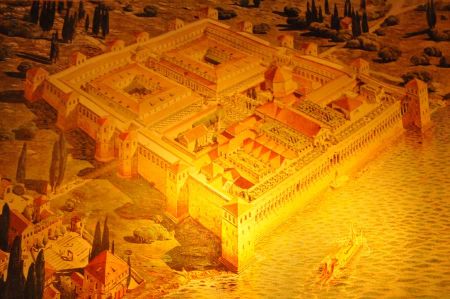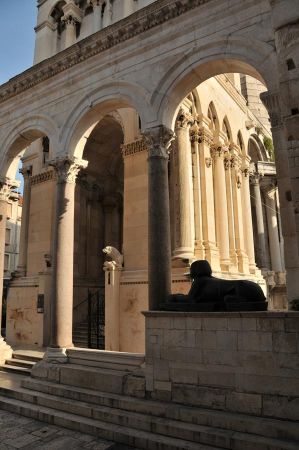Diocletian's Palace in Asphalatos, then Spalato and today Split
- Written by Portal Editor
Early the next morning we drove into Split with Robi, because we were finally going to the well-known old town of Split and to Diocletian's Palace, which actually forms the nucleus of today's city of Split.
As a local city guide, a parking space was quickly found and through colourful market stalls on the right and left of the path we headed towards Diocletian's Palace, which has also developed into the commercial and core centre of Split over the centuries.
The most famous city gate, Porta Caesarea
The Roman Emperor Diocletian had an extensive palace complex built for the last years of his life; after a century of constantly changing regents, he was the first emperor to actually experience his transition into retirement after a long reign. As an emperor who felt committed to his homeland, he had this palace built near his birthplace Dioclea (also Dognidolatz), near Solin. The building was built in record time between around 295 and 305 AD. Even back then, Diocletian's Palace was characterized by its exceptional strategic location in the center of the Roman Empire. Parts of the wall date back to the 2nd century BC. The eastern part of the city walls has been preserved to this day; this part was built from large stone blocks. The most famous city gate, Porta Caesarea, had octagonal towers on both sides. In the middle was the space for the cars, on the left and right were the passages for pedestrians. From there a road continued over “five bridges,” as the remains of the arches are called today. The road branched, one leading south and the other north, inland.
Composite structure of Roman villa and palace architecture
Architecturally, it is not just a palace, but rather a composite structure of Roman villa and palace architecture, military and urban architecture as well as sacred architecture. The palace, which was rectangular in plan, occupied an area of around 30,000 m² (around 215 × 180 meters). The building was clearly demarcated from the outside by strong walls with square corner towers and additional projecting towers on the facades, except on the south facade facing the sea. Based on the underground halls, which were only uncovered a few years ago, the dimensions of the former palace can be clearly understood, as the load-bearing support systems of the basement also continued on the ground floor. The halls in the basement were hidden by rubbish and construction rubble for many centuries; for a better view, some rooms have been preserved as they were at the time.
Three temples and the Diocletian mausoleum
Inside the palace, a cross street (Decumanus), as was usually the case in military camps or cities built by the Romans, and a longitudinal street (Cardo) divide the palace into roughly equal parts. In the northern areas, archaeological excavations revealed the remains of two large buildings with rectangular floor plans, the functions of which have not yet been fully clarified. Perhaps these buildings were military installations.
To the south of the palace, to the left and right of a central peristyle, were larger courtyards with cult monuments (three temples and Diocletian's mausoleum); In the southern quarter there were remains of the imperial apartment with many different room shapes. The actual residential wing served as a place of residence for various emperors or as a place of exile for those who had fallen from grace. Galla Placidia stayed here in 424 with her son Valentinian III before he went to Italy to overthrow the usurper John. In 461, the general Marcellinus used the palace while serving as magister militum Dalmatiae. The deposed Emperor Glycerius lived in the palace from 474 until his death in 480, and in the same year his successor Julius Nepos died of a poison attack in the palace. With the decline of the Roman Empire, the palace also fell into disrepair and served only as a military post.
Mausoleum of the imperial couple Diocletian and Prisca
Due to the continuous attacks on Salona, the residents there were forced to look for new locations that would offer protection. Most of the Salonitans who had fled and survived found refuge in the well-fortified palace of Spalatum and made themselves at home there. They converted the palace complex into a city. Today the former palace still forms the eastern part of the old town of Split and is full of shops, markets, squares and the Cathedral of St. Domnius, which in ancient times was the mausoleum of the imperial couple Diocletian and Prisca and formed the centre of the palace. The palace could never be taken by the invading "barbarians", so Spalatum - like many other Dalmatian cities - remained as a stronghold of the late Roman world - while invading peoples took over the hinterland. Also interesting in this context is the use of the word “hinterland”, which has been preserved in the Croatian language to this day.
Over the centuries the original architecture was changed, but the inhabitants of this city, called Salonae Palatium in Latin, then Split, knew how to use the structure of the palace under Byzantine, Venetian and Austro-Hungarian rule, using it as little as possible to damage.
Fish market in the palace's commercial district
It is thanks to the foresight of the residents that modern people have the opportunity to look into more than 20 centuries of cultural history in Split, to discover details from a wide variety of eras and cultures and thus to at least gain an insight into the cultural history of humanity. We were deeply impressed by the variety of details present, which can only be described if you take the time to examine them extensively.
We were also fascinated by the fish market in the trading area of the palace, as you would at least expect flies or smells from the goods being traded. There was no sign of it. The reason for this was quickly explained, because there is thermal water here whose composition prevents odor and therefore no flies can be found. Exactly which substances in the thermal water are responsible for this is still being researched.
We were then invited to the premiere of the Split region's latest promotional film in the hall of the tourism organization, so we briefly interrupted our tour of Diocletian's Palace. There should also be another surprise, but more on that later.
Diocletian's Palace – From Asphalatos to Spalato to Modern-Day Split - more details
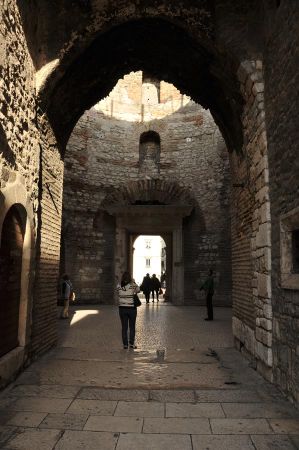 Diocletian's Palace is one of the most impressive buildings of antiquity and forms the historic heart of the Croatian city of Split. Originally built as a retirement home for the Roman Emperor Diocletian, the palace developed over the centuries into a vibrant city that is now a UNESCO World Heritage Site.
Diocletian's Palace is one of the most impressive buildings of antiquity and forms the historic heart of the Croatian city of Split. Originally built as a retirement home for the Roman Emperor Diocletian, the palace developed over the centuries into a vibrant city that is now a UNESCO World Heritage Site.
But how did an imperial palace become the foundation of a city? And what stories lie behind its ancient walls? This article takes you on a journey through the centuries, from Roman antiquity through the Middle Ages to the modern metropolis of Split.
The Beginnings: Asphalatos and the Origin of the Palace
1. Why did Diocletian build a palace in Dalmatia?
Emperor Diocletian (reigned 284–305 AD) was one of the few Roman rulers to abdicate voluntarily. When he retired from politics in 305 AD, he had a magnificent palace built in Dalmatia, near his presumed birthplace.
The region was then known as Asphalatos – a small settlement on the Dalmatian coast that was ideal for the construction of an imperial retreat.
Diocletian's Palace – Architecture and Significance
The palace is not a typical imperial residence, but rather a mixture of luxury villa and military fortress. Measuring approximately 215 x 180 meters, it covered an area of approximately 38,000 m² and was surrounded by a massive stone wall with four gates.
3. The Most Important Buildings Within the Palace
A. The Peristyle – The Heart of the Palace
The Peristyle is the central courtyard of the palace and served as a representative square where Diocletian appeared to the public. Today, it is one of the finest examples of Roman architecture in Croatia.
B. Diocletian's Mausoleum – Now the Cathedral of Split
Diocletian had a magnificent mausoleum built, which was converted into a church in the Middle Ages. Today, it is known as the Cathedral of Saint Domnius – one of the oldest churches in the world, originating from a pagan temple.
C. The Temple of Jupiter – A Sanctuary of Antiquity
Another impressive structure is the Temple of Jupiter, which was later converted into a baptistery. Its well-preserved Roman dome is particularly noteworthy.
D. The Cellars – A Window into the Past
Beneath the palace are extensive cellars that are remarkably well preserved. Today, visitors can walk through these vaults and marvel at the palace's original structure.
From Palace to City: Split in the Middle Ages
4. How did the palace become a city?
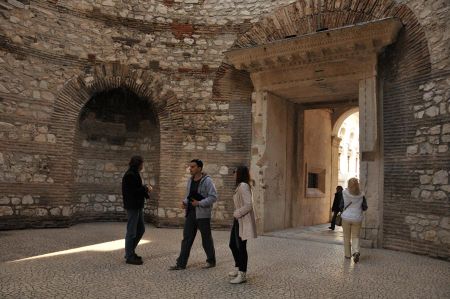 After the fall of the Roman Empire, many residents left the unsafe rural areas and sought refuge within the palace walls. This led to the slow development of Spalato, later Split.
After the fall of the Roman Empire, many residents left the unsafe rural areas and sought refuge within the palace walls. This led to the slow development of Spalato, later Split.
In the 7th century, the inhabitants of the destroyed city of Salona fled the invading Avars and Slavs and fled to the palace. They built new houses and workshops, so that the palace gradually became a medieval town.
5. The Rulers of Split – Byzantines, Venetians, and Habsburgs
Over the centuries, Split was under the control of various powers:
- Byzantine Empire (6th century)
- Kingdom of Croatia (10th century)
- Republic of Venice (15th–18th centuries)
- Habsburg Monarchy (18th–19th centuries)
Each of these eras left its mark on the city's architecture and culture.
Split Today: A Living Heritage
6. Diocletian's Palace as the Heart of Split
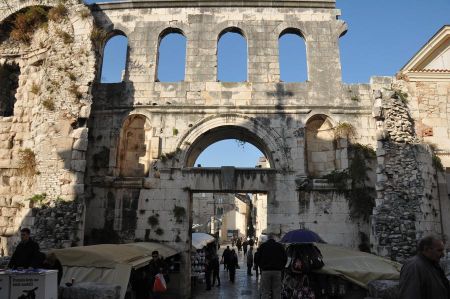 Unlike many historical sites, Diocletian's Palace is not a museum, but a vibrant part of the city. Within its ancient walls are residential buildings, cafes, restaurants, shops, and hotels.
Unlike many historical sites, Diocletian's Palace is not a museum, but a vibrant part of the city. Within its ancient walls are residential buildings, cafes, restaurants, shops, and hotels.
The palace's narrow streets and squares are bustling day and night, and visitors can enjoy the perfect blend of history and modern city life.
7. Events and Culture at the Palace
Today, Diocletian's Palace hosts numerous cultural events:
- Concerts and theater performances in the Peristyle
- The traditional Split Summer Festival
- Markets and street performers in the palace alleys
The palace is not only a historical landmark, but also a lively meeting place for locals and tourists.
Tips for your visit to Diocletian's Palace
8. The best sights in the palace
✔ Peristyle – The heart of the palace
✔ Cathedral of Saint Domnius & Bell Tower – Spectacular views
✔ Cellar vaults – Mysterious ancient rooms
✔ Temple of Jupiter – A relic of antiquity
✔ Golden Gate – The majestic entrance
9. Best time to visit
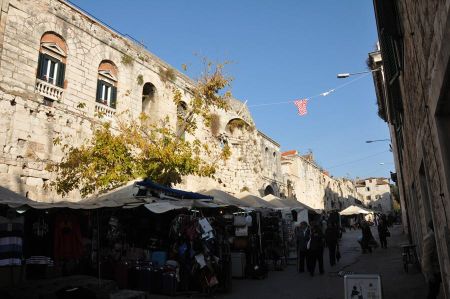 The best time to visit Split is:
The best time to visit Split is:
- Spring (April–June): Pleasant temperatures, fewer tourists
- Autumn (September–October): Warm sea, relaxed atmosphere
- Summer (July–August): Perfect for a beach holiday, but full of tourists
10. Culinary highlights in Split
Try traditional Dalmatian specialties such as:
Pašticada – Braised beef with gnocchi
Peka – Slow-cooked meat or fish under a ember dome
Dalmatian wines – Especially recommended: Plavac Mali
Conclusion: Diocletian's Palace - A Journey Through Time
Diocletian's Palace is far more than a relic of the past. It is a vibrant place where antiquity, the Middle Ages, and the modern blend in a unique way.
Whether you stroll through the Roman cellars, enjoy the view from the cathedral's bell tower, or simply sip a coffee in the peristyle, a visit to Diocletian's Palace is an unforgettable experience.
Split is not only one of Croatia's most beautiful cities, but also a living history book waiting to be discovered.
FAQs - Frequently Asked Questions about Diocletian's Palace
 1. Is there an entrance fee for Diocletian's Palace?
1. Is there an entrance fee for Diocletian's Palace?
No, the palace is free to enter. However, individual attractions such as the cathedral or the cellars have an entrance fee.
2. How long does a tour of the palace take?
At least 2-3 hours. Those who want to take their time can spend a whole day exploring the Old Town.
3. Is the palace suitable for children?
Yes! The narrow streets and historic squares are exciting for the whole family.
4. Can you stay overnight in the palace?
Yes, there are many hotels and apartments located directly within the palace walls.
5. Are there guided tours of the palace?
Yes, numerous providers offer historical tours – some with German-speaking guides.
Experience the magic of Diocletian's Palace and immerse yourself in 1,700 years of history!
Please read as well:
The Klis Fortress - bulwark to the Split peninsula
Salona - next destination of our tour along Roman road system
-
 Diocletian's Palace in Asphalatos
Diocletian's Palace in Asphalatos
Diocletian's Palace in Asphalatos
Diocletian's Palace in Asphalatos
-
 Diocletian's Palace in Asphalatos
Diocletian's Palace in Asphalatos
Diocletian's Palace in Asphalatos
Diocletian's Palace in Asphalatos
-
 Diocletian's Palace in Asphalatos
Diocletian's Palace in Asphalatos
Diocletian's Palace in Asphalatos
Diocletian's Palace in Asphalatos
-
 Diocletian's Palace in Asphalatos
Diocletian's Palace in Asphalatos
Diocletian's Palace in Asphalatos
Diocletian's Palace in Asphalatos
-
 Diocletian's Palace in Asphalatos
Diocletian's Palace in Asphalatos
Diocletian's Palace in Asphalatos
Diocletian's Palace in Asphalatos
-
 Diocletian's Palace in Asphalatos
Diocletian's Palace in Asphalatos
Diocletian's Palace in Asphalatos
Diocletian's Palace in Asphalatos
-
 Diocletian's Palace in Asphalatos
Diocletian's Palace in Asphalatos
Diocletian's Palace in Asphalatos
Diocletian's Palace in Asphalatos
-
 Diocletian's Palace in Asphalatos
Diocletian's Palace in Asphalatos
Diocletian's Palace in Asphalatos
Diocletian's Palace in Asphalatos
-
 Diocletian's Palace in Asphalatos
Diocletian's Palace in Asphalatos
Diocletian's Palace in Asphalatos
Diocletian's Palace in Asphalatos
-
 Diocletian's Palace in Asphalatos
Diocletian's Palace in Asphalatos
Diocletian's Palace in Asphalatos
Diocletian's Palace in Asphalatos
-
 Diocletian's Palace in Asphalatos
Diocletian's Palace in Asphalatos
Diocletian's Palace in Asphalatos
Diocletian's Palace in Asphalatos
-
 Diocletian's Palace in Asphalatos
Diocletian's Palace in Asphalatos
Diocletian's Palace in Asphalatos
Diocletian's Palace in Asphalatos
-
 Diocletian's Palace in Asphalatos
Diocletian's Palace in Asphalatos
Diocletian's Palace in Asphalatos
Diocletian's Palace in Asphalatos
-
 Diocletian's Palace in Asphalatos
Diocletian's Palace in Asphalatos
Diocletian's Palace in Asphalatos
Diocletian's Palace in Asphalatos
-
 Diocletian's Palace in Asphalatos
Diocletian's Palace in Asphalatos
Diocletian's Palace in Asphalatos
Diocletian's Palace in Asphalatos
https://www.alaturka.info/en/croatia/split/6309-diocletian-s-palace-in-asphalatos-then-spalato-and-today-split?layout=default%2Famp#sigProId723b7e77a7
